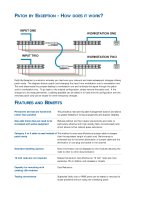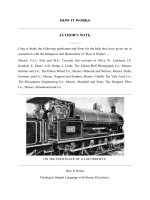How it works
Bạn đang xem bản rút gọn của tài liệu. Xem và tải ngay bản đầy đủ của tài liệu tại đây (1.18 MB, 244 trang )
TheProjectGutenbergEBookofHowitWorks,byArchibaldWilliams
ThiseBookisfortheuseofanyoneanywhereatnocostandwith
almostnorestrictionswhatsoever.Youmaycopyit,giveitawayor
re-useitunderthetermsoftheProjectGutenbergLicenseincluded
withthiseBookoronlineatwww.gutenberg.net
Title:HowitWorks
Dealinginsimplelanguagewithsteam,electricity,light,
heat,sound,hydraulics,optics,etc.,andwiththeir
applicationsto
Author:ArchibaldWilliams
ReleaseDate:April10,2009[EBook#28553]
Language:English
***STARTOFTHISPROJECTGUTENBERGEBOOKHOWITWORKS***
ProducedbyStevenGibbs,GregBergquistandtheOnline
DistributedProofreadingTeamat
Transcriber’sNote
The punctuation and spelling from the original text have been faithfully
preserved.Onlyobvioustypographicalerrorshavebeencorrected.
HOWITWORKS
AUTHOR'SNOTE.
IBEGtothankthefollowinggentlemenandfirmsforthehelptheyhavegivenme
inconnectionwiththeletterpressandillustrationsof"HowItWorks"—
Messrs.F.J.C.PoleandM.G.Tweedie(forrevisionofMS.);W.Lineham;J.F.
Kendall; E. Edser; A.D. Helps; J. Limb; The Edison Bell Phonograph Co.;
Messrs.HolmesandCo.;ThePeltonWheelCo.;Messrs.BabcockandWilcox;
Messrs.Siebe,Gorman,andCo.;Messrs.NegrettiandZambra;Messrs.Chubb;
The Yale Lock Co.; The Micrometer Engineering Co.; Messrs. Marshall and
Sons;TheMaignenFilterCo.;Messrs.BroadwoodandCo.
ONTHEFOOTPLATEOFALOCOMOTIVE.
ONTHEFOOTPLATEOFALOCOMOTIVE.
HowItWorks
DealinginSimpleLanguagewithSteam,Electricity,
Light,Heat,Sound,Hydraulics,Optics,etc.
andwiththeirapplicationstoApparatus
inCommonUse
By
ARCHIBALDWILLIAMS
Authorof"TheRomanceofModernInvention,"
"TheRomanceofMining,"etc.,etc.
THOMASNELSONANDSONS
London,Edinburgh,Dublin,andNewYork
P R E FA C E .
HOWdoesitwork?Thisquestionhasbeenputtomesooftenbypersonsyoung
and old that I have at last decided to answer it in such a manner that a much
largerpublicthanthatwithwhichIhavepersonalacquaintancemaybeableto
satisfythemselvesastotheprinciplesunderlyingmanyofthemechanismsmet
withineverydaylife.
Inordertoincludesteam,electricity,optics,hydraulics,thermics,light,anda
variety of detached mechanisms which cannot be classified under any one of
theseheads,withinthecompassofabout450pages,Ihavetobecontentwitha
comparativelybrieftreatmentofeachsubject.Thisbrevityhasinturncompelled
me to deal with principles rather than with detailed descriptions of individual
devices—thoughinseveralcasesrecognizedtypesareexamined.Thereaderwill
look in vain for accounts of the Yerkes telescope, of the latest thing in motor
cars, and of the largest locomotive. But he will be put in the way of
understanding the essential nature of alltelescopes,motors,andsteam-engines
sofarastheyareatpresentdeveloped,whichIthinkmaybeofgreaterultimate
profittotheuninitiated.
While careful to avoid puzzling the reader by the use of mysterious
phraseologyIconsiderthatthepartsofamachineshouldbegiventheirtechnical
names wherever possible. To prevent misconception, many of the diagrams
accompanyingtheletterpresshavewordsaswellasletterswrittenonthem.This
coursealsoobviatesthewearisomereferencefromtexttodiagramnecessitated
bytheuseofsolitarylettersorfigures.
Imayadd,withregardtothediagramsofthisbook,thattheyarepurposely
somewhat unconventional, not being drawn to scale nor conforming to the
canons of professional draughtsmanship. Where advisable, a part of a machine
hasbeenexaggeratedtoshowitsdetails.Asarulesolidblackhasbeenpreferred
to fine shading in sectional drawings, and all unnecessary lines are omitted. I
would here acknowledge my indebtedness to my draughtsman, Mr. Frank
Hodgson, for his care and industry in preparing the two hundred or more
diagramsforwhichhewasresponsible.
Four organs of the body—the eye, the ear, the larynx, and the heart—are
noticedinappropriateplaces.Theeyeiscomparedwiththecamera,thelarynx
withareedpipe,theheartwithapump,whiletheearfitlyopensthechapteron
acoustics.Thereaderwhoisunacquaintedwithphysiologywillthusbeenabled
toappreciatethebetterthesemarvellousdevices,farmoremarvellous,byreason
oftheirabsolutelyautomaticaction,thananycreationofhumanhands.
A.W.
UPLANDS,STOKEPOGES,BUCKS.
CONTENTS.
ChapterI.—THESTEAM-ENGINE.
Whatissteam?—Themechanicalenergyof
steam—Theboiler—Thecirculationof
waterinaboiler—Theenclosedfurnace—
Themultitubularboiler—Fire-tubeboilers
—Othertypesofboilers—Aidsto
combustion—Boilerfittings—Thesafetyvalve—Thewater-gauge—Thesteamgauge—Thewatersupplytoaboiler
13
ChapterII.—THECONVERSIONOF
HEATENERGY
INTOMECHANICALMOTION.
Reciprocatingengines—Double-cylinder
engines—Thefunctionofthefly-wheel—
Thecylinder—Theslide-valve—The
eccentric—"Lap"ofthevalve:expansion
ofsteam—Howthecut-offismanaged—
Limitofexpansiveworking—Compound
engines—Arrangementofexpansion
engines—Compoundlocomotives—
Reversinggears—"Linking-up"—Pistonvalves—Speedgovernors—Marine-speed
governors—Thecondenser
44
ChapterIII.—THESTEAMTURBINE.
Howaturbineworks—TheDeLavalturbine
—TheParsonsturbine—Descriptionof
theParsonsturbine—Theexpansive
actionofsteaminaParsonsturbine—
Balancingthethrust—Advantagesofthe
marineturbine
74
ChapterIV.—THEINTERNALCOMBUSTIONENGINE.
Themeaningoftheterm—Actionofthe
internal-combustionengine—Themotor
car—Thestarting-handle—Theengine—
Thecarburetter—Ignitionofthecharge—
Advancingthespark—Governingthe
engine—Theclutch—Thegear-box—The
compensatinggear—Thesilencer—The
brakes—Speedofcars
87
ChapterV.—ELECTRICALAPPARATUS.
Whatiselectricity?—Formsofelectricity—
Magnetism—Thepermanentmagnet—
Linesofforce—Electro-magnets—The
electricbell—Theinductioncoil—The
condenser—Transformationofcurrent—
Usesoftheinductioncoil
112
ChapterVI.—THEELECTRIC
TELEGRAPH.
Needleinstruments—Influenceofcurrenton
themagneticneedle—Methodof
reversingthecurrent—Sounding
instruments—Telegraphicrelays—
Recordingtelegraphs—High-speed
telegraphy
127
ChapterVII.—WIRELESS
TELEGRAPHY.
Thetransmittingapparatus—Thereceiving
apparatus—Syntonic
transmission—Theadvanceofwireless
telegraphy
137
ChapterVIII.—THETELEPHONE.
TheBelltelephone—TheEdisontransmitter
—Thegranularcarbontransmitter—
Generalarrangementofatelephone
circuit—Double-linecircuits—Telephone
exchanges—Submarinetelephony
147
ChapterIX.—DYNAMOSAND
ELECTRICMOTORS.
Asimpledynamo--Continuous-current
dynamos--Multipolardynamos--Exciting
thefieldmagnets--Alternatingcurrent
dynamos--Thetransmissionofpower-Theelectricmotor--Electriclighting--The
incandescentlamp--Arclamps--"Series"
and"parallel"arrangementoflamps-Currentforelectriclamps--Electroplating 159
ChapterX.—RAILWAYBRAKES.
TheVacuumAutomaticbrake—The
Westinghouseair-brake
187
ChapterXI.—RAILWAYSIGNALLING.
Theblocksystem—Positionofsignals—
Interlockingthesignals—Lockinggear—
Points—Pointsandsignalsincombination
—Workingtheblocksystem—Seriesof
signallingoperations—Singlelinesignals
—Thetrainstaff—Trainstaffandticket—
Electrictrainstaffsystem—Interlocking
—Signallingoperations—Power
signalling—Pneumaticsignalling—
Automaticsignalling
200
ChapterXII.—OPTICS.
Lenses—Theimagecastbyaconvexlens—
Focus—Relativepositionofobjectand
lens—Correctionoflensesforcolour—
Sphericalaberration—Distortionofimage
—Thehumaneye—Theuseofspectacles
—Theblindspot
230
ChapterXIII.—THEMICROSCOPE,THE
TELESCOPE,
ANDTHEMAGIC-LANTERN.
Thesimplemicroscope—Useofthesimple
microscopeinthetelescope—The
terrestrialtelescope—TheGalilean
telescope—Theprismatictelescope—The
reflectingtelescope—Theparabolic
mirror—Thecompoundmicroscope—The
magic-lantern—Thebioscope—Theplane
mirror
253
ChapterXIV.—SOUNDANDMUSICAL
INSTRUMENTS.
Natureofsound—Theear—Musical
instruments—Thevibrationofstrings—
Thesounding-boardandtheframeofa
piano—Thestrings—Thestriking
mechanism—Thequalityofanote
270
ChapterXV.—WINDINSTRUMENTS.
Longitudinalvibration—Columnsofair—
Resonanceofcolumnsofair—Lengthand
tone—Theopenpipe—Theovertonesof
anopenpipe—Whereovertonesareused
—Thearrangementofthepipesand
pedals—Separatesound-boards—
Varietiesofstops—Tuningpipesand
reeds—Thebellows—Electricand
pneumaticactions—Thelargestorganin
theworld—Humanreeds
287
ChapterXVI.—TALKING-MACHINES.
Thephonograph—Therecorder—The
reproducer—Thegramophone—The
makingofrecords—Cylinderrecords—
Gramophonerecords
310
ChapterXVII.—WHYTHEWIND
BLOWS.
Whythewindblows—Landandseabreezes
—Lightairandmoisture—Thebarometer
—Thecolumnbarometer—Thewheel
barometer—Averysimplebarometer—
Theaneroidbarometer—Barometersand
weather—Thediving-bell—Thedivingdress—Air-pumps—Pneumatictyres—
Theair-gun—Theself-closingdoor-stop
—Theactionofwindonobliquesurfaces
—Theballoon—Theflying-machine
322
ChapterXVIII.—HYDRAULIC
MACHINERY.
Thesiphon—Thebucketpump—Theforcepump—Themostmarvellouspump—The
bloodchannels—Thecourseoftheblood
—Thehydraulicpress—Householdwatersupplyfittings—Theball-cock—The
water-meter—Water-supplysystems—
Thehouseholdfilter—Gastraps—Water
engines—Thecreamseparator—The
"hydro"
350
ChapterXIX.—HEATINGAND
LIGHTING.
Thehot-watersupply—Thetanksystem—
Thecylindersystem—Howalampworks
—Gasandgasworks—Automaticstoking
—Agasgovernor—Thegasmeter—
Incandescentgaslighting
386
ChapterXX.—VARIOUSMECHANISMS.
CLOCKSANDWATCHES:—Ashorthistoryof
timepieces—Theconstructionof
timepieces—Thedrivingpower—The
escapement—Compensatingpendulums—
Thespringbalance—Thecylinder
escapement—Theleverescapement—
Compensatedbalance-wheels—Keyless
windingmechanismforwatches—The
hourhandtrain.LOCKS:—TheChubblock
—TheYalelock.THECYCLE:—The
gearingofacycle—Thefreewheel—The
change-speedgear.AGRICULTURAL
MACHINES:—Thethreshing-machine—
Mowing-machines.SOMENATURAL
PHENOMENA:—Whysun-heatvariesin
intensity—Thetides—Whyhightide
variesdaily
410
HOWITWORKS.
ChapterI.
THESTEAM-ENGINE.
Whatissteam?—Themechanicalenergyofsteam—Theboiler—Thecirculationofwater
inaboiler—Theenclosedfurnace—Themultitubularboiler—Fire-tubeboilers—Other
typesofboilers—Aidstocombustion—Boilerfittings—Thesafety-valve—Thewatergauge—Thesteam-gauge—Thewatersupplytoaboiler.
WHATISSTEAM?
IF ice be heated above 32° Fahrenheit, its molecules lose their cohesion, and
movefreelyroundoneanother—theiceisturnedintowater.Heatwaterabove
212°Fahrenheit,andthemoleculesexhibitaviolentmutualrepulsion,and,like
dormant bees revived by spring sunshine, separate and dart to and fro. If
confined in an air-tight vessel, the molecules have their flights curtailed, and
beatmoreandmoreviolentlyagainsttheirprisonwalls,sothateverysquareinch
ofthevesselissubjectedtoarisingpressure.Wemaycomparetheactionofthe
steammoleculestothatofbulletsfiredfromamachine-gunataplatemounted
on a spring. The faster the bullets came, the greater would be the continuous
compressionofthespring.
THEMECHANICALENERGYOFSTEAM.
Ifsteamisletintooneendofacylinderbehindanair-tightbutfreely-moving
piston,itwillbombardthewallsofthecylinderandthepiston;andiftheunited
pushofthemoleculesontheonesideofthelatterisgreaterthantheresistance
ontheothersideopposingitsmotion,thepistonmustmove.Havingthuspartly
got their liberty, the molecules become less active, and do not rush about so
vigorously. The pressure on the piston decreases as it moves. But if the piston
were driven back to its original position against the force of the steam, the
molecularactivity—thatis,pressure—wouldberestored.Wearehereassuming
thatnoheathaspassedthroughthecylinderorpistonandbeenradiatedintothe
air;foranylossofheatmeanslossofenergy,sinceheatisenergy.
THEBOILER.
Thecombustionoffuelinafurnacecausesthewallsofthefurnacetobecome
hot, which means that the molecules of the substance forming the walls are
thrownintoviolentagitation.Ifthewallsarewhatarecalled"goodconductors"
of heat, they will transmit the agitation through them to any surrounding
substance.Inthecaseoftheordinaryhousestovethisistheair,whichitselfis
agitated, or grows warm. A steam-boiler has the furnace walls surrounded by
water, and its function is to transmit molecular movement (heat, or energy)
through the furnace plates to the water until the point is reached when steam
generates.Atatmosphericpressure—thatis,ifnotconfinedinanyway—steam
would fill 1,610 times the space which its molecules occupied in their watery
formation. If we seal up the boiler so that no escape is possible for the steam
molecules, their motion becomes more and more rapid, and pressure is
developed by their beating on the walls of the boiler. There is theoretically no
limit to which the pressure may be raised, provided that sufficient fuelcombustionenergyistransmittedtothevaporizingwater.
To raise steam in large quantities we must employ a fuel which develops
greatheatinproportiontoitsweight,isreadilyprocured,andcheap.Coalfulfils
all these conditions. Of the 800 million tons mined annually throughout the
world,400milliontonsareburntinthefurnacesofsteam-boilers.
A good boiler must be—(1) Strong enough to withstand much higher
pressuresthanthatatwhichitisworked;(2)sodesignedastoburnitsfueltothe
greatestadvantage.
Eveninthebest-designedboilersalargepartofthecombustionheatpasses
through the chimney, while a further proportion is radiated from the boiler.
Professor John Perry[1] considers that this waste amounts, under the best
conditions at present obtainable, to eleven-twelfths of the whole. We have to
burnashillingsworthofcoaltocapturetheenergystoredinapennyworth.Yet
thesteam-engineofto-dayisthreeorfourtimesasefficientastheengineoffifty
yearsago.Thisisduetoradicalimprovementsinthedesignofboilersandofthe
machinerywhichconvertstheheatenergyofsteamintomechanicalmotion.
CIRCULATIONOFWATERINABOILER.
Ifyouplaceapotfilledwithwateronanopenfire,andwatchitwhenitboils,
you will notice that the water heaves up at the sides and plunges down at the
centre. This is due to the water being heated most at the sides, and therefore
beinglightestthere.Therisingsteam-bubblesalsocarryitup.Onreachingthe
surface, the bubbles burst, the steam escapes, and the water loses some of its
heat,andrushesdownagaintotaketheplaceofsteam-ladenwaterrising.
Fig.1. Fig.2.
FIG.1. FIG.2.
Ifthefireisveryfierce,steam-bubblesmayrisefromallpointsatthebottom,
andimpededownwardcurrents(Fig.1).Thepotthen"boilsover."
Fig. 2 shows a method of preventing this trouble. We lower into our pot a
vesselofsomewhatsmallerdiameter,withaholeinthebottom,arrangedinsuch
a manner as to leave a space between it and the pot all round. The upward
currents are then separated entirely from the downward, and the fire can be
forcedtoaverymuchgreaterextentthanbeforewithoutthewaterboilingover.
This very simple arrangement is the basis of many devices for producing free
circulationofthewaterinsteam-boilers.
We can easily follow out the process of development. In Fig. 3 we see a
simple U-tubedependingfromavesselofwater.Heatisappliedtotheleftleg,
and a steady circulation at once commences. In order to increase the heating
surfacewecanextendtheheatedlegintoalongincline(Fig.4),beneathwhich
threelampsinsteadofonlyoneareplaced.Thedirectionofthecirculationisthe
same,butitsrateisincreased.
Fig.3.
FIG.3.
Afurtherimprovementresultsfromincreasingthenumberoftubes(Fig.5),
keepingthemallontheslant,sothattheheatedwaterandsteammayrisefreely.
THEENCLOSEDFURNACE.
Fig.4. Fig.5.
FIG.4. FIG.5.
Still,alotoftheheatgetsaway.Inasteam-boilertheburningfuelisenclosed
eitherbyfire-brickora"water-jacket,"formingpartoftheboiler.Awater-jacket
signifiesadoublecoatingofmetalplateswithaspacebetween,whichisfilled
withwater(seeFig.6).Thefireisnowenclosedmuchasitisinakitchenrange.
But our boiler must not be so wasteful of the heat as is that useful household
fixture.Ontheirwaytothefunneltheflamesandhotgasesshouldactonavery
large metal or other surface in contact with the water of the boiler, in order to
giveupadueproportionoftheirheat.
Fig.6.
FIG.6.—Diagrammaticsketchofalocomotivetypeofboiler.Water
indicatedbydottedlines.Thearrowsshowthedirectiontakenbytheair
andhotgasesfromtheair-doortothefunnel.
THEMULTITUBULARBOILER.
Fig.7.
FIG.7.—TheBabcockandWilcoxwater-tubeboiler.Onesideofthebrick
seatinghasbeenremovedtoshowthearrangementofthewater-tubesand
furnace.
To save room, boilers which have to make steam very quickly and at high
pressuresarelargelycomposedofpipes.Suchboilerswecallmultitubular.They
areoftwokinds—(1)Water-tubeboilers;inwhichthewatercirculatesthrough
tubes exposed to the furnace heat. The Babcock and Wilcox boiler (Fig. 7) is
typicalofthisvariety.(2)Fire-tubeboilers;inwhichthehotgasespassthrough
tubes surrounded by water. The ordinary locomotive boiler (Fig. 6) illustrates
thisform.
TheBabcockandWilcoxboileriswidelyusedinmines,powerstations,and,
inamodifiedform,onshipboard.Itconsistsoftwomainparts—(1)Adrum, H,
intheupperpartofwhichthesteamcollects;(2)agroupofpipesarrangedon
theprincipleillustratedbyFig.5.Theboilerisseatedonarectangularframeof
fire-bricks.Atoneendisthefurnacedoor;attheothertheexittothechimney.
From the furnace F the flames and hot gases rise round the upper end of the
slopingtubes TT into thespace A,wheretheyplayupontheundersurfaceof H
before plunging downward again among the tubes into the space B. Here the
temperature is lower. The arrows indicate further journeys upwards into the
space Contherightofafire-brickdivision,andpastthedowntubes SSinto D,
whencethehotgasesfindanescapeintothechimneythroughtheopening E.It
willbenoticedthatthegreatestheatisbroughttobearon TTneartheirjunction
with UU, the "uptake" tubes; and that every succeeding passage of the pipes
bringsthegraduallycoolinggasesnearertothe"downtake"tubesSS.
Thepipes TTareeasilybrushedandscrapedaftertheremovalofplugsfrom
the"headers"intowhichthetubeendsareexpanded.
Otherwell-knownwater-tubeboilersaretheYarrow,Belleville,Stirling,and
Thorneycroft,allusedfordrivingmarineengines.
FIRE-TUBEBOILERS.
Fig. 6 shows a locomotive boiler in section. To the right is the fire-box,
surroundedonallsidesbyawater-jacketindirectcommunicationwiththebarrel
of the boiler. The inner shell of the fire-box is often made of copper, which
withstandsthefierceheatbetterthansteel;theouter,liketherestoftheboiler,is
of steel plates from ½ to ¾ inch thick. The shells of the jacket are braced
togetherbyalargenumberofrivets, RR;andthetop,orcrown,isstrengthened
byheavylongitudinalgirdersrivetedtoit,orisbracedtothetopoftheboilerby
longbolts.Alargenumberoffire-tubes(onlythreeareshowninthediagramfor
the sake of simplicity) extend from the fire-box to the smoke-box. The most
powerful "mammoth" American locomotives have 350 or more tubes, which,
with the fire-box, give 4,000 square feet of surface for the furnace heat to act
upon. These tubes are expanded at their ends by a special tool into the tubeplatesofthefire-boxandboilerfront.GeorgeStephensonandhispredecessors
experiencedgreatdifficultyinrenderingthetube-endjointsquitewater-tight,but
theinventionofthe"expander"hasremovedthistrouble.
Thefire-brickarchshown(Fig.6)inthefire-boxisusedtodeflecttheflames
towards the back of the fire-box, so that the hot gases may be retarded
somewhat,andtheircombustionrenderedmoreperfect.Italsohelpstodistribute
theheatmoreevenlyoverthewholeoftheinsideofthebox,andpreventscold
airfromflyingdirectlyfromthefiringdoortothetubes.InsomeAmericanand
Continental locomotives the fire-brick arch is replaced by a "water bridge,"
whichservesthesamepurpose,whilegivingadditionalheatingsurface.
Thewatercirculationinalocomotiveboileris—upwardsatthefire-boxend,
where the heat is most intense; forward along the surface; downwards at the
smoke-boxend;backwardsalongthebottomofthebarrel.
OTHERTYPESOFBOILERS.
Forsmallstationarylandenginestheverticalboilerismuchused.InFig.8
wehavethreeformsofthistype—AandBwithcrosswater-tubes;Cwithvertical
fire-tubes.Thefurnaceineverycaseissurroundedbywater,andfedthrougha
dooratoneside.
Fig.8.
FIG.8.—Diagrammaticrepresentationofthreetypesofverticalboilers.
TheLancashireboilerisoflargesize.Ithasacylindricalshell,measuringup
to30feetinlengthand7feetindiameter,traversedfromendtoendbytwolarge
flues,intherearpartofwhicharesituatedthefurnaces.Theboilerisfixedona
seatingoffire-bricks,sobuiltupastoformthreeflues,AandBB,shownincross
section in Fig. 9. The furnace gases, after leaving the two furnace flues, are
deflected downwards into the channel A, by which they pass underneath the
boilertoapointalmostunderthefurnace,wheretheydividerightandleftand
travel through cross passages into the side channels BB, to be led along the
boiler'sflanksto thechimneyexit C. By this arrangement the effective heating
surface is greatly increased; and the passages being large, natural draught
generallysufficestomaintainpropercombustion.TheLancashireboilerismuch
usedinfactoriesand(inamodifiedform)onships,sinceitisasteadysteamer
andiseasilykeptinorder.
Fig.9.
FIG.9.—CrossandlongitudinalsectionsofaLancashireboiler.
In marine boilers of cylindrical shape cross water-tubes and fire-tubes are
oftenemployedtoincreasetheheatingsurface.Returntubesarealsoledthrough
thewatertothefunnels,situatedatthesameendasthefurnace.
AIDSTOCOMBUSTION.
We may now turn our attention more particularly to the chemical process
calledcombustion,uponwhichaboilerdependsforitsheat.Ordinarysteamcoal
containsabout85percent.ofcarbon,7percent.ofoxygen,and4percent.of
hydrogen, besides traces of nitrogen and sulphur and a small incombustible
residue.Whenthecoalburns,thenitrogenisreleasedandpassesawaywithout
combiningwithanyoftheotherelements.Thesulphuruniteswithhydrogenand
formssulphurettedhydrogen(alsonamedsulphurousacid),whichisinjuriousto
steelplates,andislargelyresponsibleforthedecayoftubesandfunnels.More
ofthehydrogenuniteswiththeoxygenassteam.
Themostimportantelementincoalisthecarbon(knownchemicallybythe
symbol C). Its combination with oxygen, called combustion, is the act which
heats the boiler. Only when the carbon present has combined with the greatest
possible amount of oxygen that it will take into partnership is the combustion
complete and the full heat-value (fixed by scientific experiment at 14,500
thermalunitsperpoundofcarbon)developed.
Now, carbon may unite with oxygen, atom for atom, and form carbon
monoxide (CO); or in the proportion of one atom of carbon to two of oxygen,
and form carbon dioxide (CO2). The former gas is combustible—that is, will
admit another atom of carbon to the molecule—but the latter is saturated with
oxygen, and will not burn, or, to put it otherwise, is the product of perfect
combustion.Aproperlydesignedfurnace,suppliedwithadueamountofair,will
causenearlyallthecarboninthecoalburnttocombinewiththefullamountof
oxygen. On the other hand, if the oxygen supply is inefficient, CO as well as
CO2willform,andtherewillbeaheatloss,equalinextremecasestotwo-thirds
ofthewhole.Itisthereforenecessarythatafurnacewhichhastoeatupfuelata
greatpaceshouldbeartificiallyfedwithairintheproportionoffrom12to20
pounds of air for every pound of fuel. There are two methods of creating a
violentdraughtthroughthefurnace.Thefirstis—
Theforceddraught;verysimplyexemplifiedbytheordinarybellowsusedin
every house. On a ship (Fig. 10) the principle is developed as follows:—The
boilersaresituatedinacompartmentorcompartmentshavingnocommunication
withtheouterair,exceptforthepassagesdownwhichairisforcedbypowerful
fansatapressureconsiderablygreaterthanthatoftheatmosphere.Thereisonly
one "way out"—namely, through the furnace and tubes (or gas-ways) of the
boiler,andthefunnel.Sothroughtheseitrushes,raisingthefueltowhiteheat.
As may easily be imagined, the temperature of a stokehold, especially in the
tropics,isfarfrompleasant.IntheRedSeathethermometersometimesrisesto
170°Fahrenheitormore,andthepoorstokershaveaverybadtimeofit.
Fig.10.
FIG.10.—Sketchshowinghowthe"forceddraught"isproducedina
stokeholdandhowitaffectsthefurnaces.
SCENEINTHESTOKEHOLDOFABATTLE-SHIP.
SCENEINTHESTOKEHOLDOFABATTLE-SHIP.
Thesecondsystemisthatoftheinduceddraught.Hereairissuckedthrough
thefurnacebycreatingavacuuminthefunnelandinachamberopeningintoit.
Turning to Fig. 6, we see a pipe through which the exhaust steam from the
locomotive's cylinders is shot upwards into the funnel, in which, and in the
smoke-box beneath it, a strong vacuum is formed while the engine is running.
Now,"natureabhorsavacuum,"soairwillgetintothesmoke-boxiftherebea
way open. There is—through the air-doors at the bottom of the furnace, the
furnace itself, and the fire-tubes; and on the way oxygen combines with the
carbonofthefuel,toformcarbondioxide.Thepowerofthedraughtissogreat
that,asoneoftennoticeswhenatrainpassesduringthenight,red-hotcinders,
pluckedfromthefire-box,anddraggedthroughthetubes,arehurledfarintothe
air.Itmightbementionedinparenthesisthattheso-called"smoke"whichpours
fromthefunnelofamovingengineismainlycondensingsteam.Asteamship,on
the other hand, belches smoke only from its funnels, as fresh water is far too
precioustowasteassteam.Weshallrefertothislateron(p.72).
BOILERFITTINGS.
The most important fittings on a boiler are:—(1) the safety-valve; (2) the
water-gauge;(3)thesteam-gauge;(4)themechanismsforfeedingitwithwater.
THESAFETY-VALVE.
ProfessorThurston,aneminentauthorityonthesteam-engine,hasestimated
that a plain cylindrical boiler carrying 100 lbs. pressure to the square inch
containssufficientstoredenergytoprojectitintotheairaverticaldistanceof3½
miles.InthecaseofaLancashireboileratequalpressurethedistancewouldbe
2½miles;ofalocomotiveboiler,at125lbs.,1½miles;ofasteamtubularboiler,
at 75 lbs., 1 mile. According to the same writer, a cubic foot of heated water
underapressureoffrom60to70lbs.persquareinchhasaboutthesameenergy
asonepoundofgunpowder.
Steam is a good servant, but a terrible master. It must be kept under strict
control.Howeverstrongaboilermaybe,itwillburstifthesteampressureinit
beraisedtoacertainpoint;andsomedevicemustthereforebefittedonitwhich
willgivethesteamfreeegressbeforethatpointisreached.Adeviceofthiskind
iscalledasafety-valve.Itusuallyblowsoffatlessthanhalfthegreatestpressure
thattheboilerhasbeenprovedbyexperimenttobecapableofwithstanding.
Inprinciplethesafety-valvedenotesanorificeclosedbyanaccurately-fitting
plug,whichispressedagainstitsseatontheboilertopbyaweightedlever,orby
a spring. As soon as the steam pressure on the face of the plug exceeds the
counteracting force of the weight or spring, the plug rises, and steam escapes
untilequilibriumoftheopposingforcesisrestored.
Onstationaryenginesaleversafety-valveiscommonlyemployed(Fig.11).
Theblowing-offpointcanbevariedbyshiftingtheweightalongthearmsoasto
give it a greater or less leverage. On locomotive and marine boilers, where
shocks and movements have to be reckoned with, weights are replaced by
springs,settoacertaintension,andlockedupsothattheycannotbetampered
with.
Fig.11.
FIG.11.—ALEVERSAFETY-VALVE.V,valve;S,seating;P,pin;L,lever;F,
fulcrum;W,weight.Thefiguresindicatethepositionsatwhichtheweight
shouldbeplacedforthevalvetoactwhenthepressurerisestothatnumber
ofpoundspersquareinch.
Boilersaretestedbyfillingtheboilersquitefulland(1)byheatingthewater,
which expands slightly, but with great pressure; (2) by forcing in additional
waterwithapowerfulpump.Ineithercasearupturewouldnotbeattendedby
anexplosion,aswaterisveryinelastic.
The days when an engineer could "sit on the valves"—that is, screw them
down—to obtain greater pressure, are now past, and with them a considerable
proportion of the dangers of high-pressure steam. The Factory Act of 1895, in
forcethroughouttheBritishIsles,providesthateveryboilerforgeneratingsteam
inafactoryorworkshopwheretheActappliesmusthaveapropersafety-valve,
steam-gauge,andwater-gauge;andthatboilersandfittingsmustbeexaminedby
a competent person at least once in every fourteen months. Neglect of these
provisionsrenderstheownerofaboilerliabletoheavypenaltiesifanexplosion
occurs.
OneofthemostdisastrousexplosionsonrecordtookplaceattheRedcarIron
Works,Yorkshire,inJune1895.Inthiscase,twelveoutoffifteenboilersranged
side by side burst, through one proving too weak for its work. The flying
fragmentsofthisboiler,strikingthesidesofotherboilers,explodedthem,andso
thedamagewastransmitteddowntheline.Twentymenwerekilledandinjured;
whilemassesofmetal,weighingseveraltonseach,werehurled250yards,and
causedwidespreaddamage.
Thefollowingistakenfromajournal,datedDecember22,1895:"Providence
(Rhode Island).—A recent prophecy that a boiler would explode between
December 16 and 24 in a store has seriously affected the Christmas trade.
Shoppers are incredibly nervous. One store advertises, 'No boilers are being
used;liftsrunningelectrically.'Allstoreshavehadtheirboilersinspected."
THEWATER-GAUGE.
Nofittingofaboilerismoreimportantthanthewater-gauge,whichshows
the level at which the water stands. The engineer must continually consult his
gauge, for if the water gets too low, pipes and other surfaces exposed to the
furnace flames may burn through, with disastrous results; while, on the other
hand,toomuchwaterwillcausebadsteaming.Asectionofanordinarygaugeis
seeninFig.12.Itconsistsoftwoparts,eachfurnishedwithagland,G,tomakea
steam-tightjointroundtheglasstube,whichisinsertedthroughtheholecovered
bytheplug P1.Thecocks T1T2arenormallyopen,allowingtheingressofsteam
andwaterrespectivelytothetube.CockT3iskeptclosedunlessforanyreasonit
is necessary to blow steam or water through the gauge. The holes C C can be
cleanedoutiftheplugsP2P3areremoved.
Fig.12.
FIG.12.—Sectionofawater-gauge.
Most gauges on high-pressure boilers have a thick glass screen in front, so
thatintheeventofthetubebreaking,thesteamandwatermaynotblowdirectly
ontotheattendants.Afurtherprecautionistoincludetwoball-valvesnearthe
ends of the gauge-glass. Under ordinary conditions the balls lie in depressions
clearoftheways;butwhenarushofsteamorwateroccurstheyaresuckedinto
theirseatingsandblockallegress.
On many boilers two water-gauges are fitted, since any gauge may work
badlyattimes.Theglassesaretestedtoapressureof3,000lbs.ormoretothe
squareinchbeforeuse.
THESTEAM-GAUGE.
Itisoftheutmostimportancethatapersoninchargeofaboilershouldknow
what pressure the steam has reached. Every boiler is therefore fitted with one
steam-gauge; many with two, lest one might be unreliable. There are two
principaltypesofsteam-gauge:—(1)TheBourdon;(2)theSchäffer-Budenberg.
TheprincipleoftheBourdonisillustratedbyFig.13,inwhich Aisapieceof
rubber tubing closed at one end, and at the other drawn over the nozzle of a
cycletyreinflator.Ifbentinacurve,asshown,thesectionofthetubeisanoval.
Whenairispumpedin,therubberwallsendeavourtoassumeacircularsection,
because this shape encloses a larger area than an oval of equal circumference,
and therefore makes room for a larger volume of air. In doing so the tube
straightensitself,andassumesthepositionindicatedbythedottedlines.Hangan
empty"innertube"ofapneumatictyreoveranailandinflateit,andyouwillget
agoodillustrationoftheprinciple.









